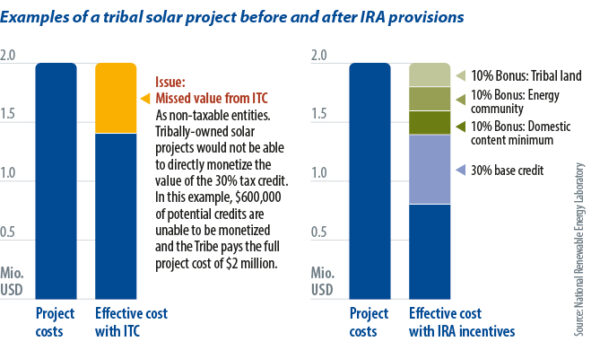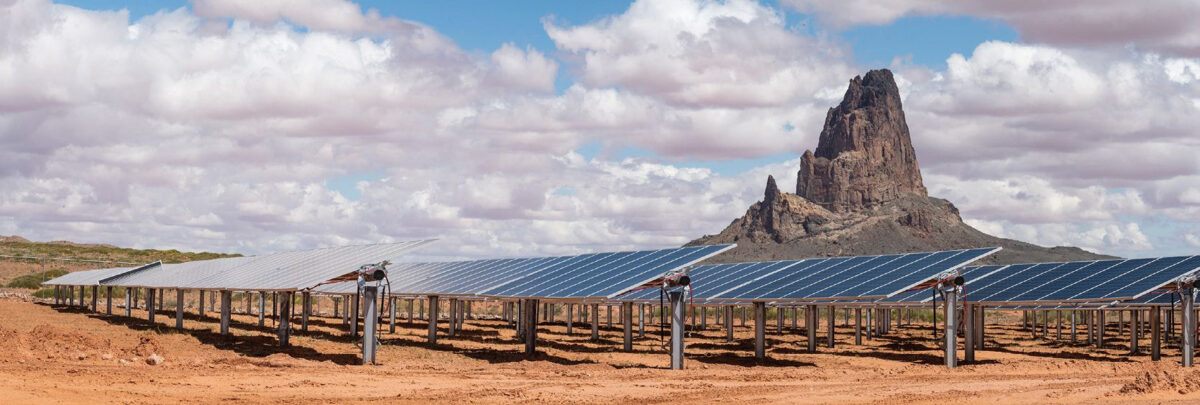In December 2020, the smokestacks of Navajo Generating Station (NGS) tumbled. The 2.25 GW coal-fired power plant had provided electricity to customers in Arizona, Nevada, and California. The closure caused hundreds of job losses.
For more than 40 years, NGS was fueled by coal mined on Navajo Nation – the largest Native American reservation in the United States. Despite this, it is estimated around 14,000 reservation homes have no electricity. When the White House issued guidance on the IRA flagship industrial policy, the text recognized tribal nations had been “left behind for too long.”
The IRA could change the game for Native American solar. Native American lands account for around 2% of the United States land mass but hold more than 5% of the nation’s solar potential. Tribes face barriers to installing solar, however. Before the IRA, tribal solar projects were a less attractive financial prospect. There was no easy way for Native American peoples to access investment tax credits (ITCs) for solar projects – worth around 30% of investment value. Native American tribes are treated as sovereign, meaning they are not subject to federal income tax. Accessing tax incentives, therefore, required creativity.
When the Navajo Tribal Utility Authority (NTUA) was developing its utility scale Kayenta solar plant, near the former Kayenta coalmine that supplied NGS, the tribal electric company set up a for-profit, limited-purpose company: NTUA Generation Inc. In this way, the utility was able to acquire tax credits and share the value with project finance partners.
Thanks to the IRA, things are more straightforward. Non-profit organizations can receive tax credits as a direct payment. That is one of many measures in the IRA providing incentives to develop renewable energy projects on tribal land. A key characteristic of the IRA’s investment tax incentives is that they can be stacked (see chart below). With these bonuses, known as adders, the credit value of the ITC could hit 70% of project cost. For example, a solar project on tribal land would benefit from the 30% base tax credit, plus a 10% tribal land bonus. If it met the requirements for domestic content and energy community bonuses, the ITC value would double to 60% of project cost. Guidance on the exact criteria for adders is still forthcoming.

Tribal ownership
Government backing for tribally owned energy is a break from precedent. There are strong feelings on this issue in Native American communities. Throughout the 20th century, Native American people and their land contributed a great deal to the United States energy mix. It is widely acknowledged Native Americans did not receive a fair share of the benefits.
“The reason the NTUA was first created is because we were ignored,” said Arash Moalemi, deputy general manager at NTUA Generation Inc. “We were ignored as far as the United States providing basic utilities on Navajo Nation and the leadership of Navajo Nation said, ‘you know, this is unacceptable. We’re going to have our own utility because outside entities are not protecting us’.”
Founded in 1959, the NTUA’s main goal is to provide electricity and other essentials such as water, internet, and cellphone service to Navajo Nation residents. In recent years, pursuing that goal has seen NTUA take ownership of utility scale solar plants on its land, starting with the Kayenta site.
Developed in two phases with local utility Salt River Project (SRP), Kayenta Solar Farm is a 55 MW project located in the El Capitan area of Navajo Nation. Phase one of the 148-hectare site was completed in 2017 and phase two came online in 2019. In addition to the $12.8 million in tax revenue that the NTUA claims Kayenta will generate for Navajo Nation over its lifetime, the project was also an economic engine during development, creating 434 construction jobs.
Those jobs were welcome but NTUA’s Moalemi knows they can’t replace the roles lost through the decommissioning of coal-fired power plants and the mines that supplied them. Solar manufacturing is a different story. There, the adders included in the IRA could really come into play.
“To alleviate that employment issue, we’re trying to create streams of opportunity related to solar manufacturing on the Navajo Nation,” said Moalemi. Discussions remain confidential but he confirmed the NTUA has spoken to PV manufacturers, and added, he has already identified buildings with conversion potential.
Solar manufacturing ambition may be in the early stages but utility scale PV development continues. In August 2023, the NTUA held a ribbon cutting ceremony for its 94 MW Red Mesa solar plant. Four months prior, NTUA had signed up to a memorandum of understanding with local generator Avangrid, part of Spanish multinational utility Iberdrola, which committed the two organizations to explore the development of 1 GW of green energy projects within Navajo Nation.
Navajo Nation’s tribal government signed a memorandum of understanding with the U.S. Department of Energy (DOE) and eight federal agencies on Dec. 6, 2023. That memorandum sets out the government’s intention to better facilitate tribal access to the funding available through the Creating Helpful Incentives to Produce Semiconductors and Science Act; the IRA; and the Bipartisan Infrastructure Law, along with programs offered annually by agencies.
Big money
Within the DOE, the Office of Indian Energy Policy and Programs is the body tasked with providing financial, technical, and educational assistance to the 574 recognized tribes in the United States. Between 2010 and 2021, the office invested $114 million in more than 200 tribal energy projects.
Popular content
Wahleah Johns, director of the Office of Indian Energy, told pv magazine that she hopes to “get $100 million out the door” in 2024. Her department’s ambition has been matched by funding. Since Johns took on the director role, the budget for her office has increased from $22 million, in the 2020-21 fiscal year, to $75 million in 2022-23. On Jan. 17, 2024, the department released a notice of intent to launch a $25 million funding opportunity in the spring.
The funding comes as an increasing number of tribes pursue energy products, according to Johns. “There is a huge need,” she said. “Sixty per cent of the [grant funding] applications that came in were new applicants and so we are seeing a huge increase of applications coming in from tribes that haven’t participated before.”
It’s not just the government that sees the energy potential of tribal land. Solv Energy is an engineering, procurement, and construction and operations and maintenance services provider with experience developing and managing solar installations on Native American land. The company worked on NTUA’s Kayenta and Red Mesa projects and is currently building the 250 MW San Juan solar and storage project near the Navajo border in New Mexico.
Opportunity knocks
“The great opportunity of Navajo is that they’ve got significant coal generation [power plants] that they’re decommissioning,” said George Hershman, chief executive officer at Solv Energy. All that decommissioning work means there are grid connections to spare – a bonus that enhances the business case when developing utility scale solar projects.
“That’s the beauty of it,” said Hershman. “You have this stranded interconnection because you had a large coal-fired plant. That interconnection was essentially at the end of a major generating line.”
Decommissioned coal-fired plants don’t just provide grid connections; they are the kind of location where the tax credit adders in the IRA can stack up.
Due to the wait for more detailed IRA guidance, Hershman said the United States solar industry hasn’t experienced the type of growth that tax incentives could provide. He is, however, optimistic for the future. “I think we’ll really start to see that in 2024 and ’25, as these guidances come out,” he added. “That market will grow dramatically once we get some of these pieces in place. Industries work because people want your products and right now, people want our products. That will give me reason to come to work every day and be bullish on the market.”
Off-grid electrification
If the Solv Energy boss is correct, it could be great news for the economies of tribes like Navajo Nation. But as the Navajo know well, generation doesn’t mean electrification – there is still the problem of the reservation’s 14,000 homes without power.
Here, utility-scale projects can provide some assistance. Moalemi said that, unlike non-tribal entities, when NTUA develops a project it looks to see how it can connect nearby Navajo households.
But the heart of the problem is the rural nature of Navajo. Grid connection quotes for remote households can run to tens of thousands of dollars – that’s economically unfeasible and it is where off-grid solar can, and does, come into play.
The NTUA offers a range off-grid solar packages, reducing or removing dependency on diesel generators for households. The utility also engages in an annual charity drive that brings electricity to rural homes. “Light up Navajo” is now in its fifth year and had a record-breaking 2023 that saw 26 utility companies from 15 states reportedly electrify 159 homes.
Solv Energy has got in on the act. Its Skip the Grid campaign sees the company provide off grid solar to Navajo households. An outreach component of the program provides children with classroom resources and solar education.
The off-grid PV systems themselves are not too complex. Typically, Solv Energy and charity partners fit households with 400 W modules and battery energy storage systems. “It’s a pretty hefty system,” said Alyssa Grant, community relations manager at Solv Energy. “In fact, you can actually run a refrigerator or a small stove.”
Light up Navajo education packs consist of basic school supplies such as pencils and scissors as well as what Grant described as a “solar 101” coloring book and a DIY solar toy car kit.
“I think the point is that we really want to inspire these kids to understand what’s being built in their back yard but also maybe inspire them to think, ‘well, this could be something I could get into’,” added Grant.
This content is protected by copyright and may not be reused. If you want to cooperate with us and would like to reuse some of our content, please contact: editors@pv-magazine.com.


4 comments
By submitting this form you agree to pv magazine using your data for the purposes of publishing your comment.
Your personal data will only be disclosed or otherwise transmitted to third parties for the purposes of spam filtering or if this is necessary for technical maintenance of the website. Any other transfer to third parties will not take place unless this is justified on the basis of applicable data protection regulations or if pv magazine is legally obliged to do so.
You may revoke this consent at any time with effect for the future, in which case your personal data will be deleted immediately. Otherwise, your data will be deleted if pv magazine has processed your request or the purpose of data storage is fulfilled.
Further information on data privacy can be found in our Data Protection Policy.